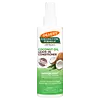What's inside
What's inside
 Key Ingredients
Key Ingredients

No key ingredients
 Benefits
Benefits

 Concerns
Concerns

No concerns
 Ingredients Side-by-side
Ingredients Side-by-side

Water
Skin ConditioningCocos Nucifera Fruit Extract
EmollientPropylene Glycol
HumectantBehentrimonium Chloride
PreservativeCocos Nucifera Oil
MaskingDimethicone
EmollientCetearyl Alcohol
EmollientGardenia Taitensis Flower Extract
Skin ConditioningTocopherol
AntioxidantTocopheryl Acetate
AntioxidantHydrolyzed Vegetable Protein
Skin ConditioningGlycerin
HumectantPhenyl Trimethicone
Skin ConditioningCaprylyl Glycol
EmollientOleth-20
CleansingEthyl Lauroyl Arginate Hcl
Skin ConditioningStearalkonium Chloride
PreservativeStearyl Alcohol
EmollientDimethyl Stearamine
EmulsifyingSaccharide Isomerate
HumectantLinseed Oil Ascorbate Esters
AntioxidantPolyquaternium-7
Sericin
Skin ConditioningFibroin
Guar Hydroxypropyltrimonium Chloride
Skin ConditioningSodium Benzoate
MaskingHydroxypropyl Starch
Caprylic Acid
CleansingXylitol
HumectantCitric Acid
BufferingSodium Citrate
BufferingIsopropyl Alcohol
SolventParfum
MaskingBenzyl Benzoate
AntimicrobialCoumarin
PerfumingBenzyl Alcohol
PerfumingWater, Cocos Nucifera Fruit Extract, Propylene Glycol, Behentrimonium Chloride, Cocos Nucifera Oil, Dimethicone, Cetearyl Alcohol, Gardenia Taitensis Flower Extract, Tocopherol, Tocopheryl Acetate, Hydrolyzed Vegetable Protein, Glycerin, Phenyl Trimethicone, Caprylyl Glycol, Oleth-20, Ethyl Lauroyl Arginate Hcl, Stearalkonium Chloride, Stearyl Alcohol, Dimethyl Stearamine, Saccharide Isomerate, Linseed Oil Ascorbate Esters, Polyquaternium-7, Sericin, Fibroin, Guar Hydroxypropyltrimonium Chloride, Sodium Benzoate, Hydroxypropyl Starch, Caprylic Acid, Xylitol, Citric Acid, Sodium Citrate, Isopropyl Alcohol, Parfum, Benzyl Benzoate, Coumarin, Benzyl Alcohol
 Reviews
Reviews

Ingredients Explained
These ingredients are found in both products.
Ingredients higher up in an ingredient list are typically present in a larger amount.
Glycerin is already naturally found in your skin. It helps moisturize and protect your skin.
A study from 2016 found glycerin to be more effective as a humectant than AHAs and hyaluronic acid.
As a humectant, it helps the skin stay hydrated by pulling moisture to your skin. The low molecular weight of glycerin allows it to pull moisture into the deeper layers of your skin.
Hydrated skin improves your skin barrier; Your skin barrier helps protect against irritants and bacteria.
Glycerin has also been found to have antimicrobial and antiviral properties. Due to these properties, glycerin is often used in wound and burn treatments.
In cosmetics, glycerin is usually derived from plants such as soybean or palm. However, it can also be sourced from animals, such as tallow or animal fat.
This ingredient is organic, colorless, odorless, and non-toxic.
Glycerin is the name for this ingredient in American English. British English uses Glycerol/Glycerine.
Learn more about GlycerinWater. It's the most common cosmetic ingredient of all. You'll usually see it at the top of ingredient lists, meaning that it makes up the largest part of the product.
So why is it so popular? Water most often acts as a solvent - this means that it helps dissolve other ingredients into the formulation.
You'll also recognize water as that liquid we all need to stay alive. If you see this, drink a glass of water. Stay hydrated!
Learn more about Water